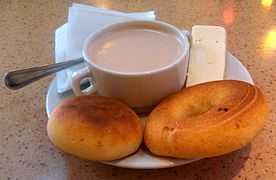Parva (food)

In the Paisa region of Colombia (Antioquia, Caldas, Risaralda and Quindio), parva refers to a wide variety of breads, usually small in size, that are used as quick snacks or morning meals, and are either sweet or savory.[1] Examples include pan de queso, pandeyuca, buñuelos, croissants and other sweets like meringue and tambourine, which are also usually baked.
Parva in Antioquia is representative in a similar way as tea is consumed in the United Kingdom, or hot chocolate in Bogotá.
History
This name for this kind of food comes from the Yiddish "parve" which denotes foods that are neither meat nor dairy, which is used in the same way in Argentina and Latin American regions populated by Sephardis since 1492. It refers to cookies and lots of fresh meals made in the afternoon quickly with flour, such as chips and sweet pies. With the distribution of such foods, the term in known in other regions outside of Antioquia, Colombia.
References
- ↑ McClausland-Gallo, Patricia. Secrets of Colombian Cooking. Hippocrene Books, 2004. 8. Print.